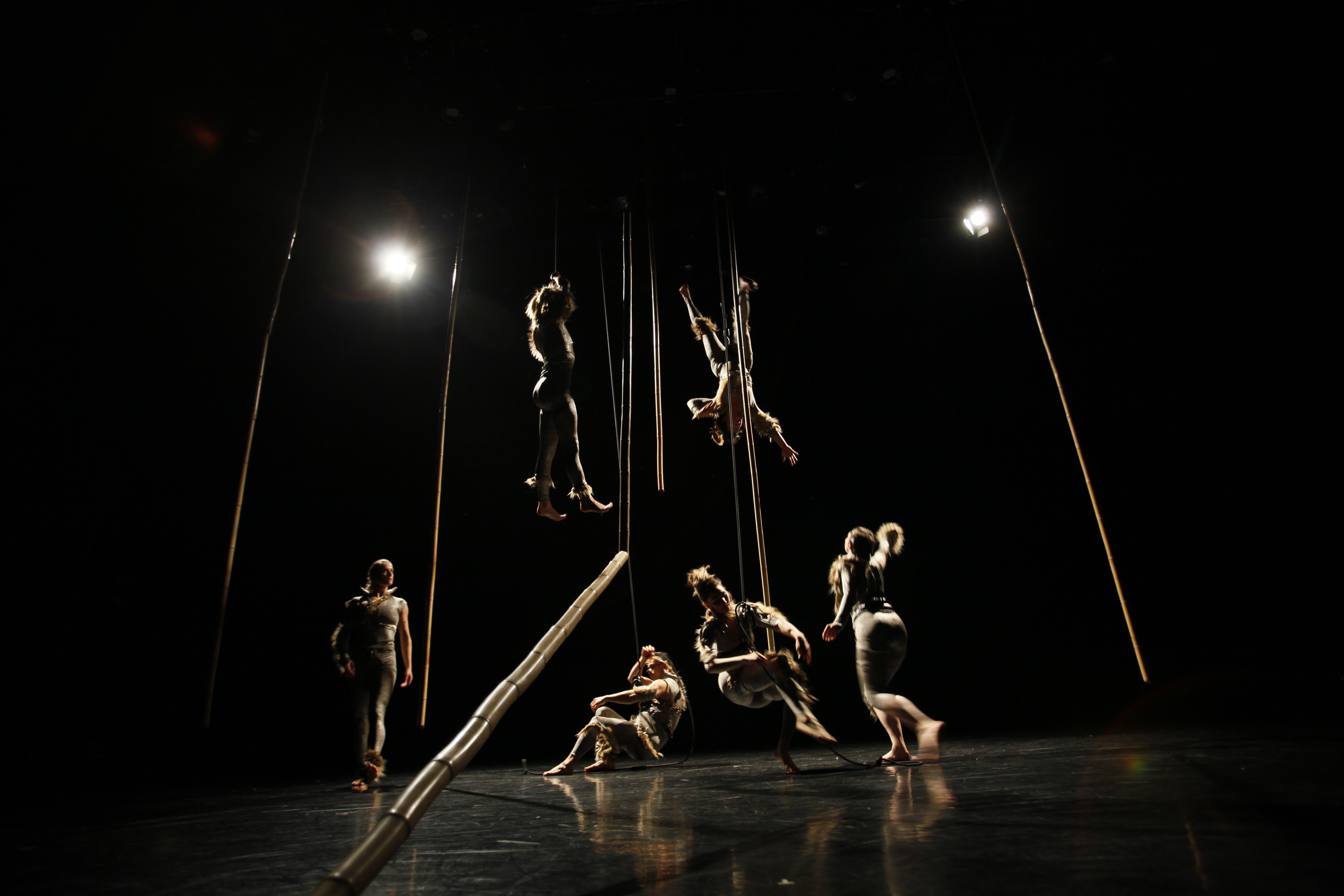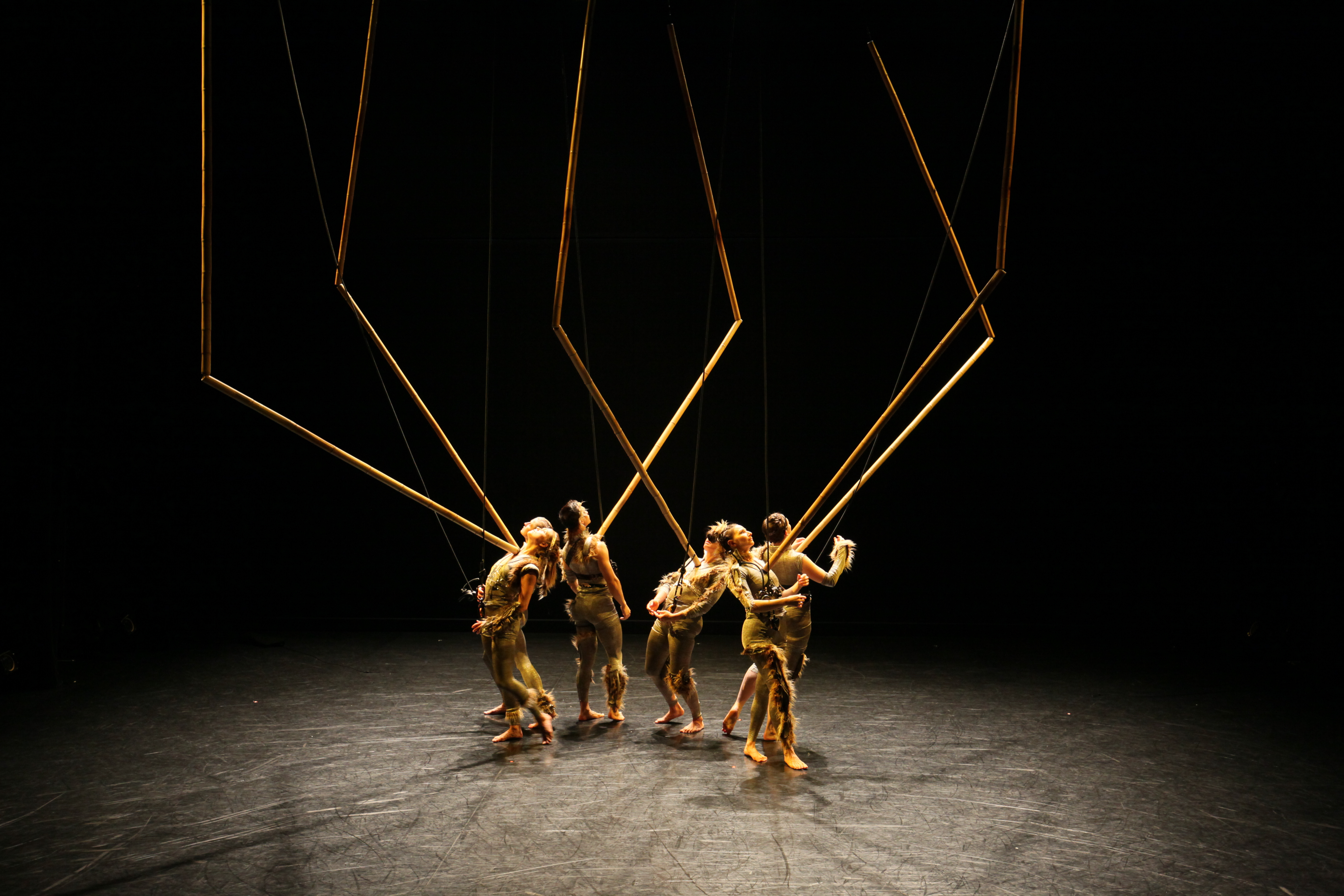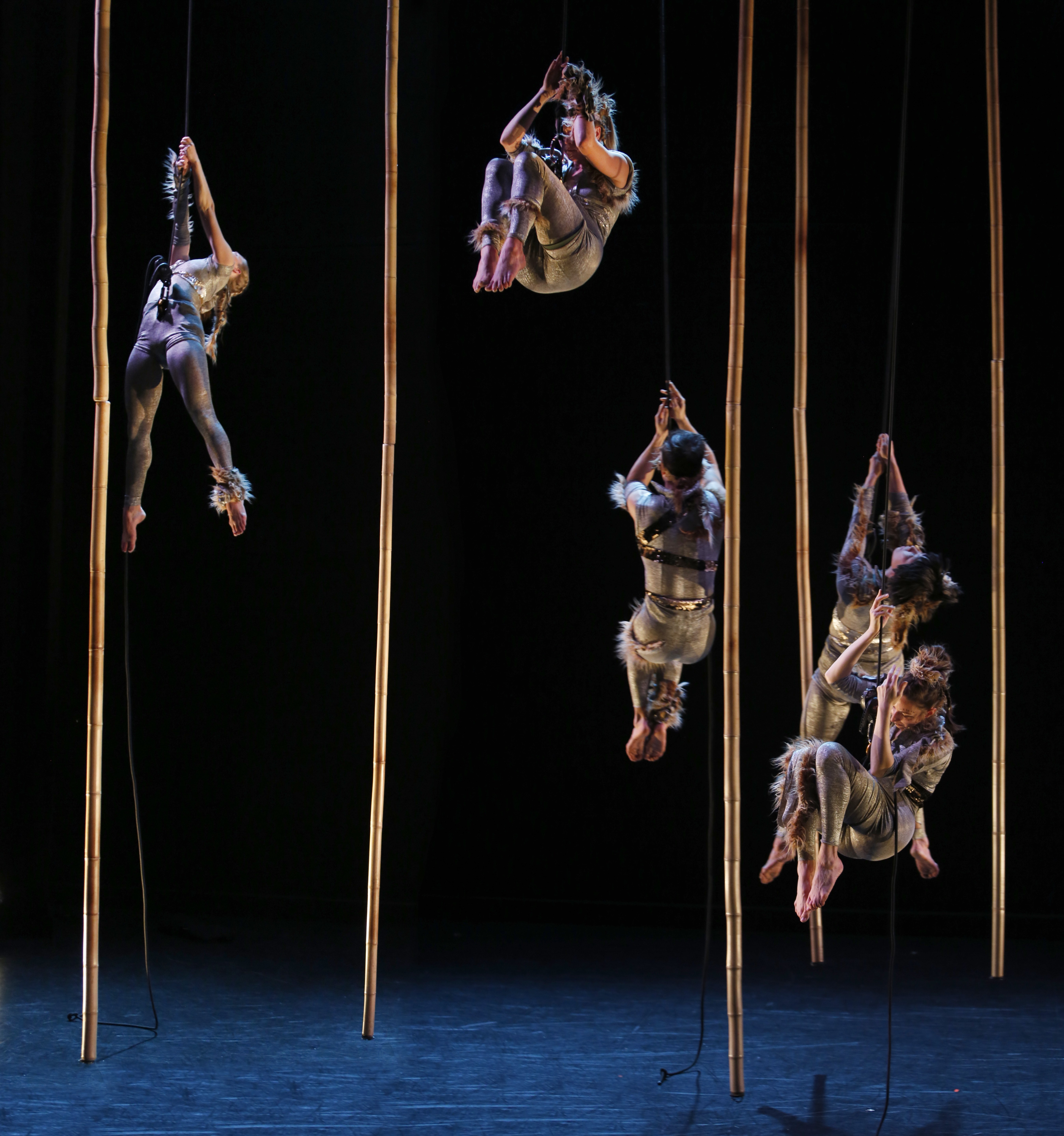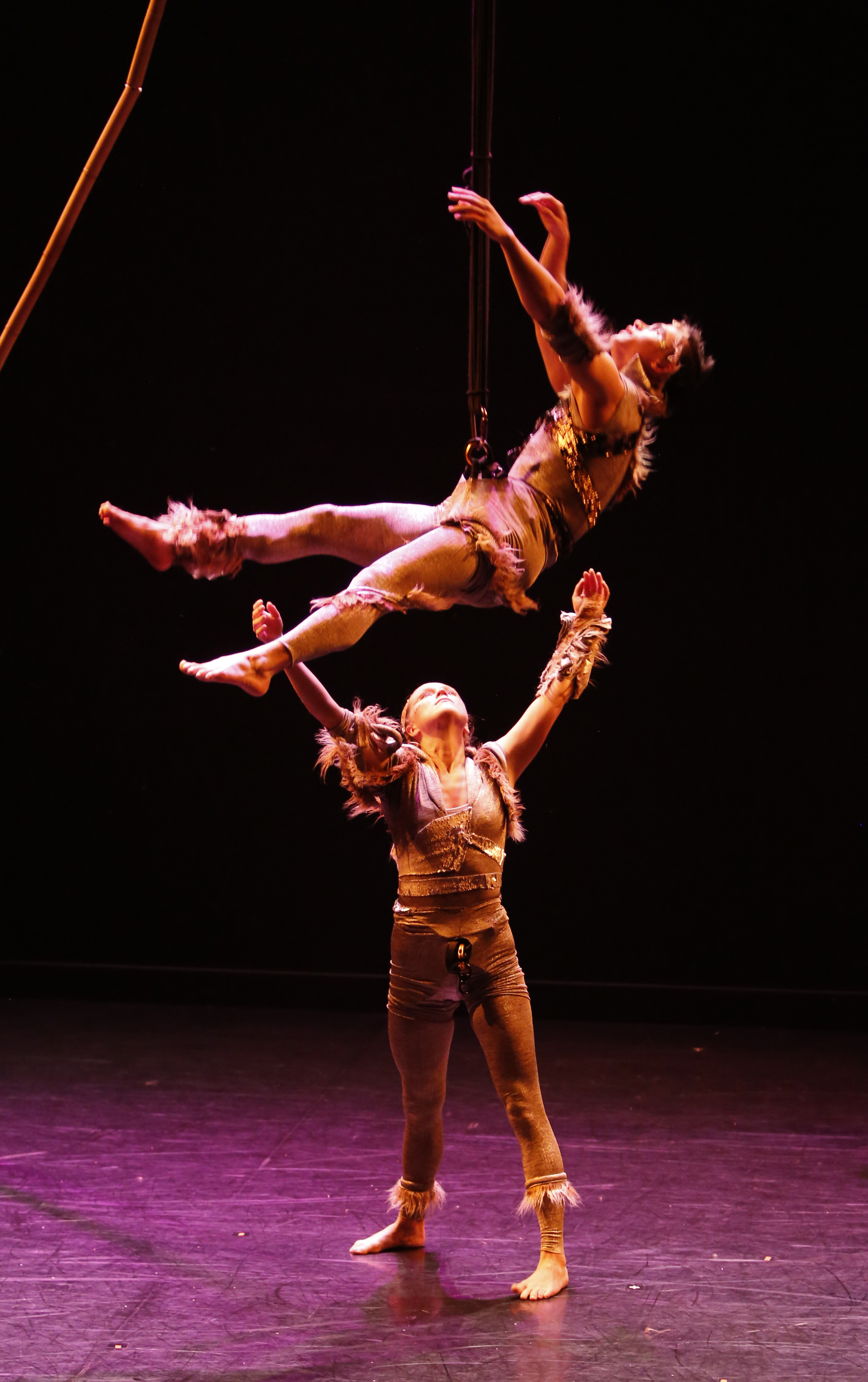
Aeriosa has been part of Vancouver’s cultural landscape for almost a decade now. And quite literally so! The dance company has performed aerial dance pieces amongst the lofty branches of Stanley Park trees, on the textured cliffside of the Stawamus Chief, and the outer walls of countless downtown high rises as they mirror blue skies. If you’re unfamiliar with aerial dancing think fluid contemporary motion brought to life by dancers suspended in the air with wires, fabric and other creative materials. It is an acrobatic feat but the fluidity and elegance of the dancers, as they coast on waves of wind, make it more of a dance than say, Cirque du Soleil. Think flying. Think absence of all fear. Think blurred lines between the earth and air. Think clouds coasting. Think poetry devoid of constraints.
I first stumbled upon the masterful artform of aerial dance when I was walking down Granville Street on my lunch break a couple of years ago. On the inside wall of a tall building were two dancers performing full-blown choreography in billowing, colourful skirts. They were moving across the vertical face of the wall unaffected by the forces of gravity. I was spellbound. Later when I found out they also performed amongst the sky-high verdure of Stanley Park I couldn’t help but think of “Crouching Tiger Hidden Dragon” sequences.
Have I got you hooked yet?
As you can already tell, Aeriosa is not your regular dance company. They like to go for that which is impossible and tame the great uncharted. As Aeriosa develop their love affair with dancing in the air, they also pay painful attention to safety, rigging innovation, athletic discipline and risk management. A lot of precision and calculation goes into their stagings which always look effortlessly carefree and natural. Julia Taffe, artistic director of the company, imbibes her unique talents from years as a ballet and contemporary dancer, rock climber and a stunt performer into the collective vision of the company. She is joined at Aeriosa by dancers with impressive backgrounds in both dance and rock climbing.
To choreograph the company’s latest show “Second Nature,” Taffe tapped into the remarkable human ability to metamorphasize at various stages of our lives and paired it with the cultural symbolism of bamboo. We asked Julia some of our most pressing questions about this innovative piece.
Julia, “Second Nature” depicts the miracles of human adaptability and our transformations throughout life. What made you decide that aerial dancing would be the perfect vehicle to tell this story?
Aerial dance is about connecting earth to air. Creating shapes and formations in the air requires people to be physically connected….a connection between earth and humanity. As we allow life experiences to transform us, we move from shape to shape – from earth to air.
Could you tell us about your own journey into aerial dancing and Aeriosa? Did you watch a performance that inspired you? You have backgrounds in ballet, contemporary dance, rock climbing, and stunt performance. What was the progression of your creative identity like?
I started off as a contemporary dancer and first trained in Winnipeg where I had friends who also introduced me to rock-climbing. I saw rock-climbing as another way of connecting my movement practice to nature. Using climbing equipment and being suspended in a harness gave me the ability to dance on stone and express my art in new ways.
Aerial dancing requires an immense amount of strength. How long does one train to be an aerial dancer? How do you become fearless when it comes to dancing at heights and thwarting the security of gravity?
Training to be an aerial dancer requires doing. It also requires spending progressive time upside down! The fear of heights is instinctive and present for a reason….to keep us safe. As dancers, we manage fear by being conscientious about safety checks and doing the proper technical preparation.
Can you tell us a little about your dancers? How did the troupe come together and do they have any interesting backgrounds?
The cast is comprised of six dancers; five women and one man. There are a couple of dancers who have been with me since 2009 and there are several new dancers who joined the company two years ago. They have dance training in ballet, contemporary dance and several are rock-climbers.

The depiction of our relationship with nature is an important theme in your work, for example, the treetop performance in Stanley Park. What draws you to tell these stories? Do you think we are losing a lot of ourselves as we distance ourselves from nature? What is your own relationship with nature?
Relationships, location and nature are what inspire me. I don’t have much to say if I create dance without nature and so I am drawn to tell those stories. Yes, I think we lose ourselves when we distance from nature.
Choreographing pieces in the air must be quite different from choreographing pieces on the ground. How do you visualise the aerial pieces? Especially in “Second Nature”, how did the choreography germinate?
There is a certain amount of geometry involved when placing dancers in the landscape. Site-work can be very different than working in the theatre. Scale and perspective are key elements to consider when creating aerial pieces – especially outdoors. We have to be true to physics and to the ropes attached to us which dictate certain movement.
The choreographic idea germinated with a trip to Hong Kong in 2013 where Aeriosa performed three shows for New Year’s Eve at Sha Town New Town Centre. During our free time, we rode around on bicycles and noticed the plentiful use of bamboo against the ultra-modern architecture of Hong Kong. It was used in a variety of applications from patching walls, scaffolding, hanging banners and tunnels were woven for workers to travel from building to building. Its uses and versatility were remarkable.
Can you tell us what it was like working with Dan Law, the contemporary installation artist? How did you communicate to him what you were looking for and how was he able to realise your vision?
I first knew Dan Law from my hometown community in Tofino. I was interested in his work with cedar and also discovered he was a puppet maker. We took time in the winter to have a brainstorming session about bamboo architecture and structures and things progressed from there.
Second Nature Promo from Aeriosa Dance Society on Vimeo.
Can you touch a little on the costumes and the music (by Juno Award winner, Jordan Nobles) you have chosen for this piece?
The costumes were designed by Ninon Parent; a local circus artist and fashion designer who is a co-founder of “The Underground Circus”, a company based in Vancouver. She is inventive and creative with her designs. She even harvested bamboo from her backyard and it has been incorporated into the show!
I first worked with Jordan Nobles in 2010 on a project for the Culture Olympiad which took place in Library Square. We hit it off and have been working together ever since. He also contributed bamboo from his collection to Second Nature. While creating this work I have found many people with stories and connection to bamboo.
What about aerial dancing is your favourite? Why do you love it? Can you describe what it feels like when you are dancing up in the air? Is it liberation? Greater and more elegant ease of motion? Or a state of exerted control to stay safe?
I am drawn to aerial dance because it harnesses power. It draws in information, energy, calmness….then condenses and explodes out. You are free to change perspective and sensation while soaring in the air and you see things from different angles.

What have been your personal influences in terms of dance? Are you influenced by other artforms?
My inspiration keeps changing. I create from a dreamlike place which draws inspiration from books, images, visual art, film and nature.
You are an artist with many skills and talents and you have found a way to merge them all and create something unique. What advice would you give young artists who have multiple talents but don’t know how to go about being true to who they are?
Be fearless in terms of creativity. Be comfortable knowing that not everyone will see things the way you do. Surround yourself with people who support you but be prepared to do everything yourself.
When making art what is most important to you? Maybe in terms of the stories you tell or how you create and who you employ etc. etc.
Maintaining a balance and a sense of humour while being true to myself and producing work that has something meaningful to say.

“Second Nature” plays at the Scotiabank Dance Centre till the 26th of May. Get your tickets here!
– Prachi Kamble
